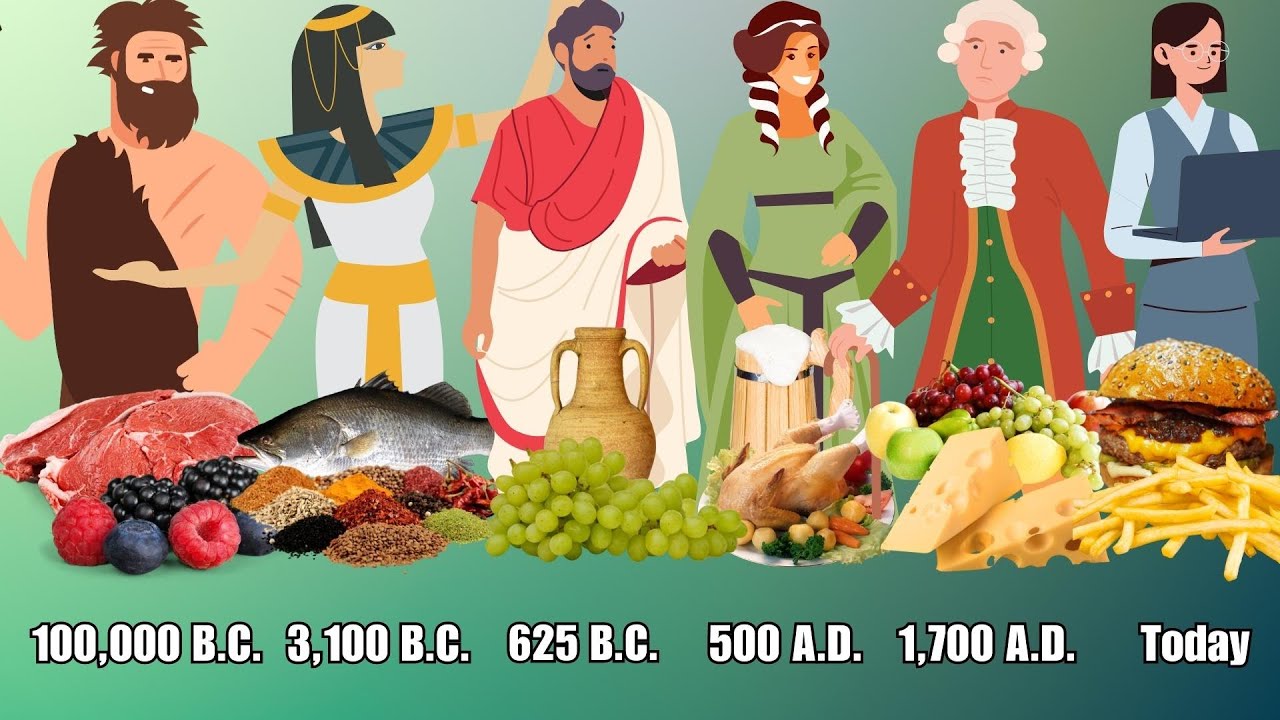In recent years, there has been a significant trend towards the appreciation of traditional foods, including superfoods, coupled with their adaptation and recipe modifications to align with contemporary health trends.
As individuals become increasingly health-conscious, the demand for natural and whole foods has risen sharply, primarily driven by concerns regarding industrialized food production.
This article examines the convergence of tradition and innovation, emphasizing well-known traditional foods such as fermented items, bone broth, and ancient grains and ancestral wisdom.
It explores how these ingredients are being reimagined in modern recipes, products, and supplements, while also discussing the benefits they provide for health, cultural heritage and culinary heritage, and food culture.
Why Are Traditional Foods Being Adapted for Modern Health Trends?
.jpg_00.jpeg)
The adaptation of traditional foods to meet modern health trends and food trends adaptation is a phenomenon influenced by the growing awareness among health-conscious consumers, who prioritize mindful eating and are seeking nutritious diets that honor culinary traditions while promoting overall wellness.
As individuals become more cognizant of the importance of sustainable farming practices, the nutritional value of food, and various dietary restrictions, including gluten-free and plant-based preferences, the significance of ancestral diets and traditional cooking methods is re-emerging, offering a rich array of flavors, nutritional profiles, and health benefits.
The increasing emphasis on clean eating and intuitive eating and ingredient transparency and food ethics is fundamentally transforming the perception and consumption of traditional foods within today’s culinary landscape.
1. Increased Interest in Health and Wellness
The growing interest in health and wellness among consumers has resulted in a notable increase in the popularity of traditional foods known for their functional properties and health benefits, particularly among health-conscious individuals who prioritize their well-being.
This trend reflects a broader movement towards a wellness culture and holistic health, where individuals are increasingly adopting clean eating practices and choosing whole, minimally processed foods that enhance health rather than detract from it.
Functional foods, recognized for their nutritional benefits, are becoming more prominent as consumers acknowledge the significance of incorporating elements such as probiotics, antioxidants, omega fatty acids, and adaptogenic herbs and herbal infusions into their diets.
Contemporary health trends are shifting dietary preferences toward these nutrient-dense options, facilitating informed choices that align with individual health objectives. The integration of nutritional science with everyday eating habits underscores a proactive approach to health, demonstrating how traditional foods can play a vital role in achieving optimal well-being.
2. Desire for Natural and Whole Foods
A rising demand for natural, organic, and whole foods has generated significant interest in traditional culinary practices, as consumers increasingly seek organic ingredients that are consistent with their ethical eating values and diverse culinary preferences.
This trend is indicative of a broader movement toward ingredient transparency, where individuals are becoming more cognizant of the contents of their meals. Whole foods, which are rich in nutrients and devoid of harmful additives, are fundamental to a balanced diet and contribute to overall health and wellness.
The revival of traditional foods not only serves to preserve cultural heritage but also underscores the significance of seasonal, locally sourced, and indigenous ingredients. As individuals seek more clarity regarding their food sources, they are naturally drawn to options that promote nourishment for both the body and mind, thereby fostering a deeper connection to their meals.
3. Concerns About Industrialized Food Production
Concerns regarding the environmental and health impacts of industrialized food production have prompted a notable shift toward traditional foods, emphasizing sustainable practices and food sustainability that enhance food security and promote climate-conscious eating.
This growing awareness has resulted in a resurgence in local sourcing and the adoption of sustainable farming methods and eco-friendly practices, which not only enrich the soil but also promote biodiversity.
By utilizing time-tested agricultural techniques and seasonal produce, communities can effectively reduce their carbon footprint while benefiting from fresher, nutrient-dense foods. Individuals are increasingly acknowledging the advantages of incorporating traditional food systems into their diets, as these options are often sourced from smaller farms that prioritize quality over quantity.
Consequently, the embrace of traditional foods serves as a significant countermeasure to the adverse effects of industrialization, contributing to both personal health and environmental resilience.
What Are Some Traditional Foods Being Adapted for Modern Health Trends?
Traditional foods are being adapted to align with contemporary health requirements through innovative food adaptation techniques and ingredient swaps that enhance their nutritional value while preserving culinary heritage. This process results in a harmonious fusion of flavors and health benefits.
From ancient grains to fermented foods, these culinary treasures are being reimagined in modern recipes designed for health-conscious consumers embracing food as medicine who seek flavorful and nutritious options tailored to their dietary preferences.
1. Fermented Foods
Fermented foods, including kimchi and yogurt, have garnered significant recognition for their probiotic content and associated health benefits, thereby underscoring the value of traditional food preservation methods and culinary artistry.
In numerous cultures worldwide, these exceptional foods exemplify the art of transformation and culinary arts, converting basic ingredients into rich and flavorful dishes that are both nourishing and advantageous for gut health.
For example, miso in Japan, sauerkraut in Germany, and kombucha in various regions highlight the diversity and creativity inherent in fermentation practices. These foods not only increase the intake of beneficial bacteria, which may enhance digestion and immune function, but they also play a critical role in nutritional strategies and food education designed to address contemporary health challenges.
Embracing these fermented foods can contribute to a more holistic approach to wellness, reflecting their increasing popularity within modern health trends.
2. Bone Broth
.jpg_01.jpeg)
Bone broth, a fundamental component of many ancestral diets, is recognized for its significant nutritional value, offering essential minerals and promoting gut health. This has garnered the attention of health-conscious consumers.
In recent years, it has gained traction as a notable health trend, especially among individuals seeking natural methods to improve their well-being. Rich in collagen, amino acids, and vital nutrients, bone broth not only enhances immune function but also supports nutritional balance but also contributes to skin elasticity and joint health.
Its versatility allows for seamless incorporation into a variety of contemporary dishes, ranging from soups to sauces, while drawing upon traditional cooking techniques that prioritize slow simmering for optimal nutrient extraction.
This connection to heritage cooking resonates with many individuals as they adopt a holistic approach to nutrition, aiming to integrate time-honored practices with modern health trends.
3. Ancient Grains
Ancient grains such as quinoa and farro are being increasingly recognized for their nutritional benefits and versatility, providing gluten-free alternatives that cater to contemporary dietary restrictions while preserving cultural heritage.
These grains are not only valuable sources of protein, fiber, and nutrient-rich foods, but they also supply essential vitamins and minerals that contribute to overall health. Incorporating ancient grains into modern diets can offer satisfying alternatives for individuals with gluten sensitivities or other dietary requirements, allowing them to move away from traditional wheat-based products.
Many of these grains hold significant cultural importance and culinary storytelling, having supported communities for centuries.
By integrating them into contemporary meals, individuals can enhance their culinary experiences and food storytelling while honoring the traditions and histories that have influenced their use across generations.
4. Medicinal Mushrooms
Medicinal mushrooms, historically esteemed in traditional medicine and herbal remedies, are increasingly recognized as functional foods that provide a range of health benefits, effectively bridging the gap between ancient culinary traditions and food heritage and contemporary health trends.
These fungi not only serve to enhance the flavors of various dishes, but they are also renowned for their bioactive compounds and health claims, which support immune function, reduce inflammation, and promote overall well-being.
Varieties such as reishi, lion’s mane, and turkey tail have gained significant attention due to their distinct properties, appealing to both health-conscious individuals and culinary innovators.
By incorporating these mushrooms into their daily meals, promoting food diversification—whether through broths, teas, or supplements—individuals can embrace the wisdom of traditional practices and food innovation trends while benefiting from modern dietary advancements that prioritize wellness and nutrition.
5. Adaptogenic Herbs
Adaptogenic herbs, esteemed in traditional herbal medicine, are increasingly recognized for their potential health benefits, aligning with modern wellness trends focused on stress management and overall well-being.
These remarkable plants, utilized for centuries across various cultures, are acknowledged for their capacity to assist the body in adapting to stressors while promoting balance and harmony.
As more individuals pursue holistic approaches to enhance their health and well-being, adaptogens such as ashwagandha, rhodiola, and holy basil have become popular options, frequently included in supplements and wellness products. These herbal remedies are cherished for their potential to support holistic health and nutrition.
The rising interest in these herbs signifies a broader movement towards natural remedies and preventive care, as individuals increasingly acknowledge the importance of nurturing both body and mind in today’s fast-paced environment. This shift reflects a modern health trend that values the integration of holistic health and nutrition into everyday life.
By incorporating adaptogens into their daily routines, many are experiencing improved vitality, resilience, and overall health benefits.
How Are Traditional Foods Being Adapted for Modern Health Trends?
Traditional foods are being thoughtfully adapted into contemporary recipes through innovative food experimentation and techniques for recipe modification that address the diverse dietary preferences of health-conscious consumers. These adaptations often include the use of organic ingredients and superfoods, catering to modern health trends and dietary changes.
This evolution in culinary practices not only enhances the flavors and presentation of these ancestral foods but also promotes dietary customization by incorporating organic ingredients and superfoods, like ancient grains, thus making them suitable for today’s fast-paced lifestyle. This also supports the trend of clean eating and the use of nutrient-rich foods in modern health trends.
1. Incorporating Traditional Foods into Modern Recipes
Incorporating traditional foods into modern recipes enables chefs to explore culinary fusion, resulting in dishes that celebrate diverse flavor profiles while enhancing the nutritional value of meals. This practice often includes integrating plant-based and gluten-free options, catering to various dietary restrictions and preferences.
By blending age-old ingredients, such as quinoa and farro, with contemporary techniques like sous-vide cooking or molecular gastronomy, culinary professionals can create innovative meals that resonate with both cultural heritage and modern preferences. These culinary techniques not only enhance the flavor but also adhere to dietary changes and food trends adaptation.
For example, integrating spices from traditional cuisines—such as harissa or garam masala—into contemporary salads or soups not only enhances the flavor complexity of the dish but also promotes a greater appreciation for cultural diversity and food culture.
The key to this practice lies in understanding the interactions of different textures, aromas, and tastes, which enables the creation of harmonious dishes that honor the past while appealing to today’s evolving palate. This also reflects the balance between tradition vs. innovation in culinary arts.
2. Creating New Products with Traditional Foods
.jpg_10.jpeg)
Food innovation has facilitated the development of new products derived from traditional foods, resulting in artisanal offerings that not only preserve cultural heritage but also address the needs of health-conscious consumers. These innovations often involve allergen-free and nutrient-dense options that appeal to the modern diet.
For example, the introduction of ancient grain snacks, such as quinoa and spelt-based crisps, illustrates how traditional ingredients are being modernized to meet the increasing demand for nutritious alternatives. These products not only honor the culinary history of various cultures but also feature impressive nutritional profiles, appealing to a market that is becoming increasingly focused on wellness and dietary diversification.
Moreover, the rise in popularity of fermented foods like kimchi and kombucha underscores their probiotic benefits while reintroducing age-old recipes to contemporary palates. This synthesis of traditional processes with modern dietary preferences, including veganism and low-carb diets, exemplifies the evolving landscape of food innovation, where the essence of the past aligns with the aspirations of today’s health-conscious consumers.
3. Using Traditional Foods in Supplements
The incorporation of traditional foods into dietary supplements highlights the increasing acknowledgment of their health benefits, as they are progressively recognized as functional foods that can enhance overall well-being. This trend signifies a greater appreciation for age-old dietary practices that have demonstrated their value over time, providing a rich array of nutrients and therapeutic properties. Such functional foods also support health optimization and holistic health practices.
For example, numerous cultures have traditionally utilized ingredients such as turmeric, ginger, and various fermented foods not only for their distinctive flavors but also for their potential to strengthen immunity, reduce inflammation, and improve gut health. As modern consumers become more health-conscious, the importance of these time-honored ingredients in contemporary diets is significant. This is especially evident in the rise of food as medicine and the inclusion of these ingredients in herbal infusions and health claims.
By integrating traditional foods into dietary supplements, individuals can access a wealth of knowledge that fosters holistic health while effectively bridging the gap between historical and modern culinary practices. This practice also promotes food sustainability and the use of nutrient-rich foods.
4. Promoting Traditional Food Practices
Promoting traditional food practices is essential for food education, as it encourages a deeper appreciation for cultural heritage and fosters community-supported agriculture initiatives that connect consumers with local producers. These practices also highlight the importance of local sourcing and sustainable eating.
By embracing these practices, communities can significantly enhance their overall health, given that traditional diets typically emphasize whole foods and seasonal ingredients, which are both nutritionally dense and environmentally sustainable. This approach also supports mindful eating and the appreciation of food heritage.
This approach cultivates a sense of identity, allowing individuals to explore their culinary history and understand the importance of sourcing ingredients from the land. It also promotes ethical eating and food ethics in the context of traditional food practices.
Furthermore, educating individuals about the nutritional values and local benefits of these time-honored recipes enables them to make informed choices that positively impact their well-being and contribute to the ecosystem. This educational approach often includes discussions on food preservation and ingredient swaps for healthier options.
Strengthening connections to local agriculture through traditional foodways not only preserves cultural narratives but also promotes sustainability for future generations. This connection supports community resilience and eco-friendly practices in food sourcing.
What Are the Benefits of Incorporating Traditional Foods into Modern Health Trends?
Incorporating traditional foods into contemporary health trends offers numerous advantages, including improved health outcomes, the preservation of cultural heritage, and the promotion of sustainable food practices. This integration also aligns with the principles of clean eating and ancestral wisdom.
This integration not only enhances dietary diversity with nutrient-dense options but also bolsters local economies and cultivates a greater appreciation for the culinary diversity inherent in traditional food systems. It also encourages the use of functional foods and seasonal ingredients in daily diets.
1. Nutritional Benefits
The nutritional benefits of traditional foods are considerable, providing functional foods that are high in nutrient density and essential for maintaining optimal health. These foods, often rooted in cultural heritage, are not only abundant in vitamins and minerals but also contain beneficial compounds that contribute to overall well-being. This nutrient density is particularly valuable in the context of modern health trends and health-conscious consumers.
For example, fermented foods such as kimchi and yogurt deliver probiotics that enhance gut health, while ancient grains like quinoa and farro offer complete proteins and a variety of B vitamins. These traditional foods align with the principles of functional cooking and culinary diversity.
Traditional dietary practices, which emphasize the use of seasonal and locally sourced ingredients, ensure a diverse intake of nutrients, promoting a balanced diet that modern eating habits may sometimes neglect. This approach supports the philosophy of food as medicine and the benefits of macrobiotic diets and plant-forward cooking.
Consequently, these elements of traditional nutrition are essential for enhancing immunity, reducing inflammation, and promoting longevity. Understanding these nutritional profiles helps in the development of recipes that support health and wellness.
2. Cultural Preservation
Cultural preservation is an essential component of integrating traditional foods into contemporary diets, as it ensures the continuity of culinary traditions and the rich food heritage that characterizes diverse societies. This integration also supports the education of culinary arts and the importance of food storytelling in cultural identity.
By valuing age-old recipes and the narratives they encapsulate, individuals reinforce their community identity and cultivate a sense of belonging. These culinary practices act as a conduit connecting generations, enabling individuals to share their cultural narratives and values through flavors and cooking techniques. This connection also supports cooking from scratch and the preservation of family recipes.
The practice of preparing and enjoying traditional dishes not only pays homage to ancestors but also serves to educate younger generations about their cultural roots and the significance of diverse cuisines. This education is often facilitated through cooking classes and nutritional education programs.
Therefore, embracing traditional foods transcends the notion of mere sustenance; it becomes a celebration of heritage, reflecting the resilience and vibrancy of cultures worldwide. This celebration often involves understanding the health promotion aspects and the benefits of intuitive eating practices.
3. Sustainable Food Practices
.jpg_11.jpeg)
Sustainable food practices associated with traditional foods significantly enhance community health and reduce environmental impact, thereby fostering a healthier planet and population. These practices include principles of biodynamic farming and eco-friendly practices in food production.
These practices are deeply embedded in local cultures and often emphasize the use of seasonal ingredients, which not only supports local farmers but also minimizes the carbon footprint associated with the transportation of food over long distances. This emphasis on seasonal eating supports the principles of food sustainability and ethical eating.
By adopting traditional culinary techniques, communities can establish a stronger connection to their local ecosystems, promoting mindfulness regarding food choices. This mindfulness supports the broader food system and promotes the community’s resilience.
Incorporating regional produce into diets reinforces food sovereignty, enabling communities to regain control over their food sources and promoting biodiversity. This approach also supports the broader food accessibility and nutritional balance in diets.
Ultimately, this approach not only nourishes the body but also contributes to the cultivation of a sustainable future for generations to come. This adherence to food ethics and sustainable practices helps in maintaining the ecological balance.
4. Promoting Local and Small-Scale Agriculture
Promoting local and small-scale agriculture through traditional foods is essential for enhancing food security while strengthening community ties and fostering economic resilience. This promotion also supports food safety and food labeling initiatives.
By embracing the culinary heritage deeply rooted in regional practices, communities celebrate their unique identities and simultaneously improve their nutritional landscape. Traditional foods, typically cultivated using sustainable methods, are vital to local agriculture, as they reinforce biodiversity and help maintain environmental integrity. This approach is aligned with the principles of food diversification and sustainable eating practices.
This emphasis on utilizing locally sourced ingredients not only supports the livelihoods of farmers but also encourages consumers to engage with community initiatives that prioritize health and wellness. Ultimately, such efforts contribute to improved food security, ensuring that residents have access to fresh, nutritious options that enhance both personal and community health. These efforts also promote the broader concept of community-supported agriculture and food storytelling in connecting people to their food sources.
Frequently Asked Questions
What are traditional foods?
Traditional foods are dishes that have been passed down through generations, often using locally sourced ingredients and traditional cooking methods specific to a certain culture or region. These dishes are a vital part of food culture and culinary heritage, showcasing the ancestral wisdom of communities.
How are traditional foods being adapted for modern health trends?
Traditional foods are undergoing adaptation for modern health trends by incorporating more nutritious ingredients such as superfoods and ancient grains, and altering cooking methods to make them healthier and more accessible to a health-conscious audience. This adaptation also involves recipe modifications to enhance flavor profiles while maintaining nutritional balance.
Why is there a growing interest in traditional foods for modern health?
There is a growing interest in traditional foods for modern health because they often use whole, unprocessed ingredients, known for their high nutrient density, and can provide a variety of health benefits such as improved digestion and increased nutrient intake. Embracing these foods supports holistic health and well-being.
Are traditional foods suitable for all dietary restrictions?
Traditional foods can be suitable for various dietary restrictions as many ethnic cuisines offer dishes that are naturally gluten-free, dairy-free, and/or vegetarian. With mindful eating practices and careful ingredient swaps, these dishes can fit into veganism and other dietary changes. However, it is important to check for any potential allergens or ingredients that may not align with specific dietary needs.
How can traditional foods be adapted to fit a vegan diet?
Traditional foods can be adapted to fit a vegan diet by substituting animal-based ingredients with plant-based alternatives, such as using tofu or tempeh instead of meat, and replacing dairy with non-dairy alternatives like coconut milk or cashew cheese. This plant-forward cooking approach also embraces food sustainability and ethical eating practices.
Do traditional foods lose their cultural significance when adapted for modern health trends?
No, traditional foods do not lose their cultural significance when adapted for modern health trends. In fact, the adaptation and preservation of these dishes can help to promote and celebrate cultural heritage while also making them more accessible to a wider audience. This process of food trends adaptation encourages culinary diversity and the integration of traditional flavors with modern cuisine.

My name is Bruno, I have been a writer for 5 years and I work with website creation. My goal is to provide true information to readers. In fact, on this site I write about cultures and traditions, which I have been passionate about since childhood.




